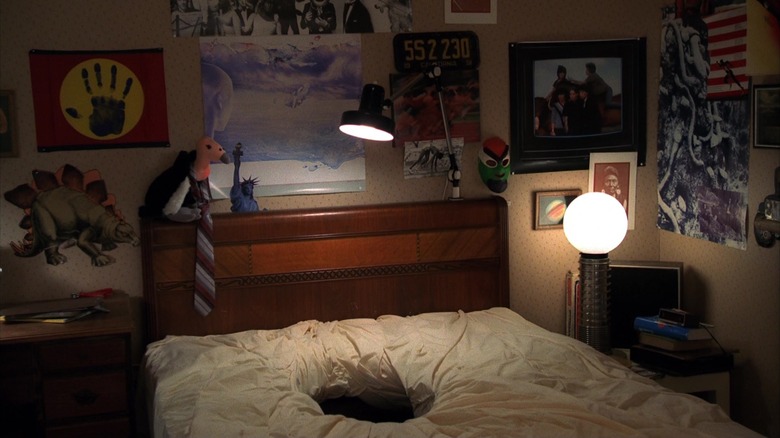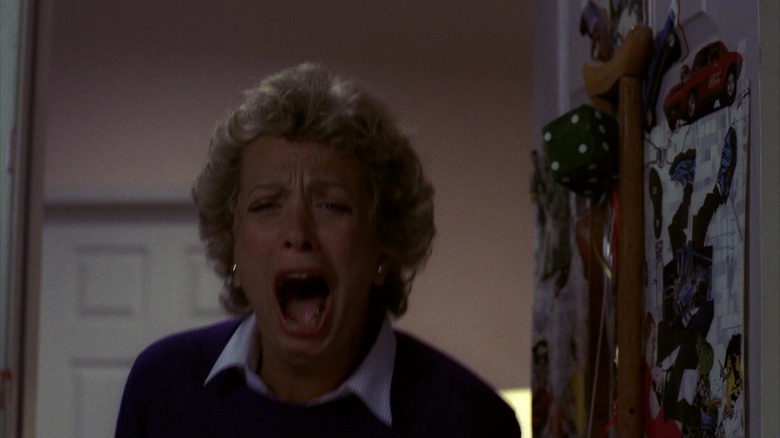Johnny Depp’s Elm Street Death Scene Nightmare Nearly Killed Someone For Real

The death of Glen (Johnny Depp) in Wes Craven’s 1984 horror film “A Nightmare on Elm Street” made the record books. “Nightmare on Elm Street,” of course, is about the ghost of a murderous child — Freddy Krueger, played by Robert Englund — who can stalk and murder people in their dreams. When they die in their sleep, they also die in the waking world, sometimes in spectacularly bloody and undoubtedly supernatural ways. At the beginning of the film, the character of Tina (Amanda Wyss) is, in her dream, torn out of a wall and hung from the ceiling by Freddy, a killer who gleefully flouts the laws of physics.
Something similar happens to the laid-back Glen. At the film’s climax, when the stakes are at their highest, Glen – happily listening to his headphones – dozes off at a crucial moment. Glen’s nap gave Freddy a chance to work his killing magic. A portal opens in his bed and Glen is physically sucked inside. A moment later, Glen reappears from the portal… like a geyser of blood. Just like Tina, Glen’s liquefied remains spill onto the ceiling and stick to it.
To shoot Glen’s death scene, the film crew built a rotating set. The whole thing was physically inverted, after which the “blood” was poured from above. Invert the image and it’s a geyser. It’s a really cool effect. In fact, there was so much liquid that the film’s technicians created, essentially, a foot-deep, chamber-shaped kiddie pool filled with blood-colored water on Glen’s ceiling. However, as revealed in the documentary film “Never Sleep Again” (via Film School Rejects), it appears that the water-filled set caused an electrical short near Glen’s ceiling light, leading to a minor electrocution of a crew member.
A Nightmare on Elm Street’s blood geyser accidentally electrocuted a crew member
As mentioned, for Glen and Tina’s death scenes, Craven built a huge rotating chamber set. Everything was in place and the camera was rolling with the set. This allowed the actors to roll with it, making it appear as if they (and/or blood) were on the walls and ceiling. It’s a technique that dates back at least as far as Fred Astaire’s wall dance number in the 1951 film “Royal Wedding.” For Glen’s death, in particular, the set was sealed to allow blood to pool without leaking. The filmmakers then poured gallons and gallons of blood-colored water through an opening in the bed, filling the set.
However, because the effect was so complicated, the creators of “Nightmare on Elm Street” only allowed themselves one take to get it right. There would be no chance of cleaning and drying the whole thing and starting again. For the most part, everyone was careful and tried to avoid any mistakes in shedding blood correctly. However, the crew forgot to take into account Glen’s ceiling light, which was not covered in plastic or protected from the liquid by anything other than its traditional glass dome. This caused an electrical current to surge through the water and into the body of the (unnamed) crew member who was pouring it.
Cinematographer Jacques Haitkin recalled the incident vividly, stating in “Never Sleep Again” that “as soon as [the blood] hit the ceiling and hit the light, it immediately electrified the water. So the guy pouring the water was electrocuted. »
And things got worse from there. The liquid can cause many problems, all of which apparently occurred on the set of “Nightmare on Elm Street.”
This fake blood caused other problems on the set of Nightmare on Elm Street.
Haitkin and Craven also recalled that the water not only electrocuted one of the crew members, but the entire set also went haywire. It seems that when the set was finally filled with fake blood, it began to move unpredictably, throwing the entire rotating mechanism of the set out of balance. Those controlling the spinning mechanism lost control of the room, and it returned to its normal position without warning, ripping cables and devices from the walls and spilling fake blood everywhere. The jet caused additional electrical shorts in the additional lighting it hit, and the lights all went out. It was, well, a nightmare. As Craven says:
“[The blood] came into all the lights and there were these huge flashes of lightning in the darkness. […] We were shooting in the dark with all these sparks.”
When enough blood had flowed out and the whole thing stopped moving, everything finally stopped. One poor crew member was stuck on set, tied upside down, in the dark, covered in blood, for about 20 minutes while everyone else rushed to get things back up and running. Rotating sets, as has been mentioned, had been used on many, many projects before “Nightmare on Elm Street.” But none of them had to deal with the weight and physics of being filled with fake blood. It’s a miracle the set didn’t collapse or someone else was more seriously injured.
But the “Nightmare on Elm Street” team succeeded. And Craven managed to film one of the strangest and most memorable deaths in horror film history.






